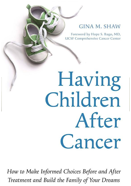Having Children After Cancer: How to Make Informed Choices Before and After Treatment and Build the Family of Your Dreams
encontrar mi
Author: Gina M. Shaw
Publisher: Celestial Arts, 2011
Price: $16.99 US, 198 pages
ISBN: 9781587613654
OncoLinkRating:
A diagnosis of cancer brings about many emotions; these may includefear, anxiety and a feeling of powerlessness, among many others. When a young adult receives a cancer diagnosis, his or her mind may also go to dreams of a family and how those dreams may be affected by the diagnosis and treatment of cancer. Many oncology physicians are more consistently discussing fertility preservation, but often the initiation of these discussions still falls to the patient.
Gina Shaw was fortunate enough to have a physician who discussed her options and offered her access to fertility preservation specialists. She chose not to undergo these procedures, though she reflects upon the importance of being an informed participant in that decision. She discovered that there was a lack of information available to patients about fertility preservation options, and decided to put her medical-writer skills to work to create a sort of "one-stop shop" resource for those interested in having children after cancer.
Whether you are newly diagnosed and researching fertility preservation, or have completed therapy and are now wondering about fertility options, Gina provides a comprehensive look at options for men and women, both tried and true and cutting edge/experimental. The book presents accurate, up to date information on these technologies. Ms. Shaw also addresses the options of surrogates (for eggs, embryos and/or carrying the pregnancy) and adoption (both domestic and international). The personal stories of both Gina and other cancer survivors included throughout the bookhelp the reader to see real life examples of the many ways to build a family after cancer. Having a family after cancer isn't always a simple undertaking, and may involve realities of the effects of therapy on fertility, the cost involved in assisted reproduction or adoption, and the emotional ups and downs of such avenues to parenthood. This book addresses the emotional hardships and financial obstacles that cancer survivors may face in the journey towards parenting, often using survivor's stories to demonstrate the challenges one may encounter and how one family successfully coped.
If you are a woman and are fortunate enough to become pregnant, Gina has included a chapter on pregnancy after cancer, addressing questions including appropriate monitoring, cancer medications during pregnancy, cancer screening during pregnancy and breastfeeding after cancer. And for those who have a child at home, what to say when they ask, what's cancer?
Having Children After Cancer is a great resource for any young adult who wishes to explore fertility preservation prior to treatment, or options for family building after cancer. It is also appropriatefor any healthcare professional who works with patients of childbearing age, and would likely assist any oncology nurse or physician in acting as an informed resource for patients and survivors.

